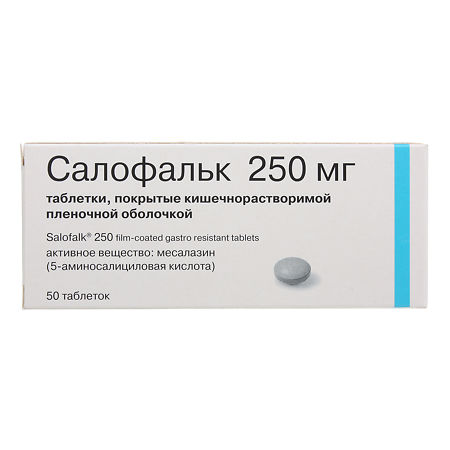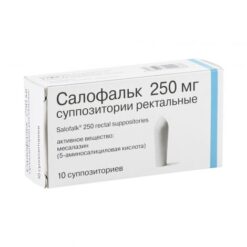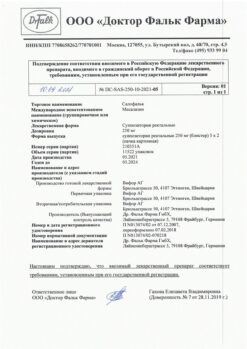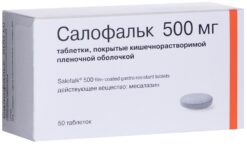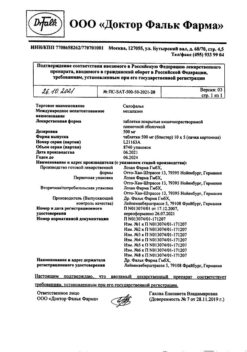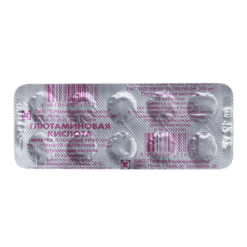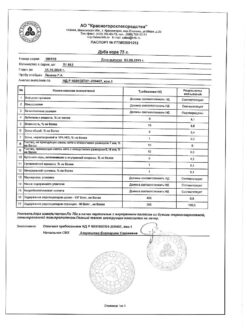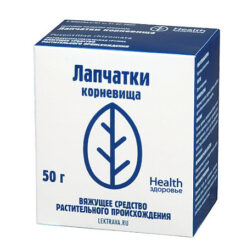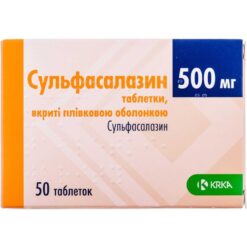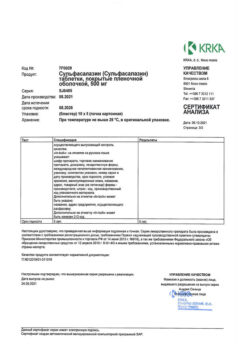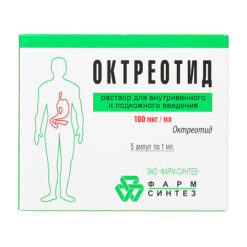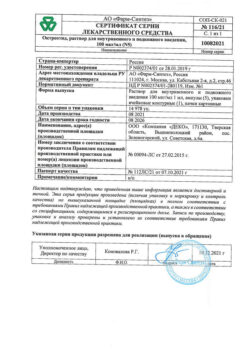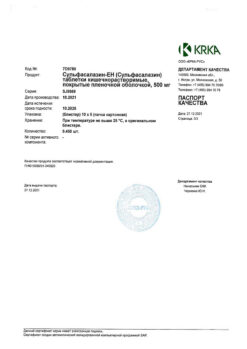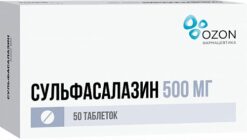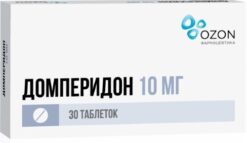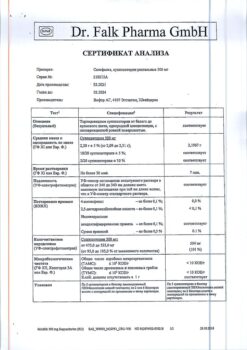No products in the cart.
Salofalc, 250 mg 50 pcs.
€14.56 €12.62
Description
Salofalc – anti-inflammatory.
Pharmacodynamics
It has a local anti-inflammatory effect due to inhibition of cyclooxygenase and synthesis of PG and leukotrienes. It inhibits migration, degranulation, phagocytosis of neutrophils and secretion of immunoglobulins by lymphocytes. It has an antioxidant effect (due to the ability to bind with free oxygen radicals and destroy them). Mesalazine can also trap radicals formed from reactive oxygen compounds.
The results obtained in in vitro studies indicate a possible role of lipooxygenase inhibition. The effect on the GH content in the intestinal mucosa has also been shown. When administered orally, mesalazine has predominantly a local effect in the intestinal mucosa and submucosa layer, acting on the intestinal lumen side. Therefore, it is important that mesalazine is accessible to the area of inflammation.
The ratio of systemic bioavailability to plasma concentration of mesalazine is not significant in terms of therapeutic efficacy, but rather serves as a factor influencing safety.
The fact that Salofalc granules are resistant to gastric juice and are characterized by pH-dependent (due to Eudragit L coating) and delayed (due to matrix structure of the granules) release of mesalazine helps to ensure the release of the active substance in the right place.
Indications
Indications
Nonspecific ulcerative colitis; Crohn’s disease (prevention, treatment of exacerbations).
Pharmacological effect
Pharmacological effect
Salofalk is anti-inflammatory.
Pharmacodynamics
It has a local anti-inflammatory effect due to inhibition of cyclooxygenase and the synthesis of PG and leukotrienes. Slows down migration, degranulation, phagocytosis of neutrophils, as well as the secretion of immunoglobulins by lymphocytes. It has an antioxidant effect (due to the ability to bind to free oxygen radicals and destroy them). Mesalazine can also scavenge radicals generated from reactive oxygen species.
Results obtained from in vitro studies suggest a possible role for lipoxygenase inhibition. The effect on the PG content in the intestinal mucosa has also been shown. When taken orally, mesalazine has a predominantly local effect in the intestinal mucosa and submucosal layer, acting from the intestinal lumen. It is therefore important that mesalazine is available to the area of inflammation.
The relationship between systemic bioavailability and plasma concentrations of mesalazine is not significant in terms of therapeutic efficacy, but rather serves as a factor influencing safety.
Ensuring the release of the active substance in the right place is helped by the fact that Salofalk granules are resistant to gastric juice and are characterized by pH-dependent (thanks to the coating in the form of Eudragit L) and delayed (due to the matrix structure of the granules) release of mesalazine.
Special instructions
Special instructions
Salofalk is recommended to be used only under the supervision of a physician.
Before starting treatment, during therapy (14 days after it starts and then every 4 weeks), and after the end of therapy (every 3 months), blood and urine tests should be performed.
To monitor renal function, it is recommended to determine the level of urea and creatinine in the blood serum and study the urine sediment.
Active ingredient
Active ingredient
Mesalazine
Composition
Composition
1 tablet contains:
Active substance:
mesalazine 250 mg;
Excipients:
sodium carbonate;
MCC;
povidone;
croscarmellose;
glycine;
colloidal silicon dioxide;
calcium stearate;
Shell:
methacrylic acid and methacrylate copolymer 1:1; talc; macrogol; titanium dioxide; hypromellose; iron oxide yellow dye (E172, CFR21); butyl methacrylate.
Contraindications
Contraindications
hypersensitivity to the components of the drug and other salicylic acid derivatives;
blood diseases;
peptic ulcer of the stomach and duodenum;
deficiency of glucose-6-phosphate dehydrogenase;
hemorrhagic diathesis;
severe renal/liver failure;
children’s age (up to 6 years);
phenylketonuria.
With caution: pregnancy (first trimester), mild to moderate renal/liver failure, lung diseases (especially bronchial asthma).
Side Effects
Side Effects
From the gastrointestinal tract: diarrhea, nausea, abdominal pain, flatulence, loss of appetite, vomiting, increased levels of liver enzymes in the blood, hepatitis.
From the central nervous system: headache, depression, dizziness, sleep disturbance, malaise, paresthesia, convulsions, tremor, tinnitus.
Reactions associated with hypersensitivity: skin rash, itching, erythema, fever, bronchospasm, pericarditis and myocarditis, acute pancreatitis, interstitial nephritis, nephrotic syndrome. Isolated cases of allergic alveolitis and pancolitis have been observed. Under certain conditions, mesalazine and drugs with a similar chemical structure can lead to the development of a syndrome similar to systemic lupus erythematosus syndrome.
Other side effects: rarely – tachycardia, arterial hypertension or hypotension, chest pain, shortness of breath; myalgia, arthralgia. In some cases, proteinuria, hematuria, crystalluria, oliguria, and anuria were observed; anemia, leukopenia, agranulocytosis, thrombocytopenia, hypoprothrombinemia; decreased tear production, alopecia.
Interaction
Interaction
With simultaneous administration, it is possible to enhance the effect of coumarin anticoagulants, increase the toxicity of methotrexate, reduce the diuretic effect of spironolactone and furosemide, and reduce the effectiveness of probenecid and rifampicin.
Enhances the hypoglycemic effect of oral antidiabetic agents – sulfonylurea derivatives.
Overdose
Overdose
Symptoms: nausea, vomiting, weakness, drowsiness.
Treatment: symptomatic therapy.
Storage conditions
Storage conditions
In a place protected from light, at a temperature not exceeding 25 °C.
Shelf life
Shelf life
3 years
Manufacturer
Manufacturer
Dr Falk, Germany
Additional information
| Shelf life | 3 years |
|---|---|
| Conditions of storage | In a light-protected place at a temperature not exceeding 25 °C. |
| Manufacturer | Dr. Falk, Germany |
| Medication form | enteric-soluble film-coated tablets |
| Brand | Dr. Falk |
Other forms…
Related products
Buy Salofalc, 250 mg 50 pcs. with delivery to USA, UK, Europe and over 120 other countries.

